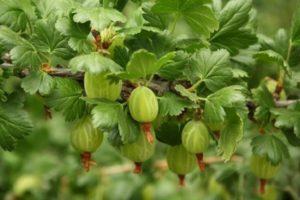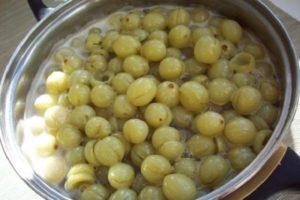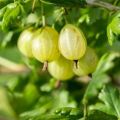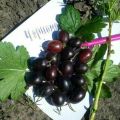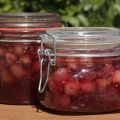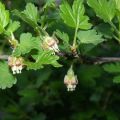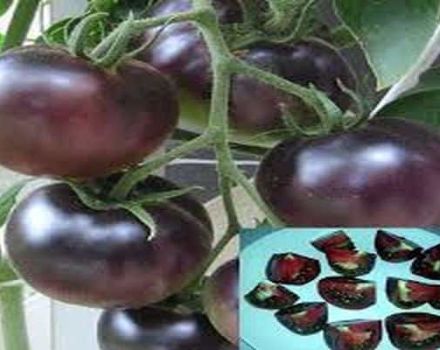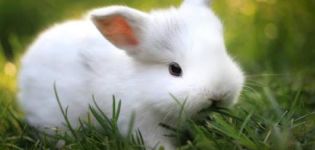Optimal timing and best ways to propagate gooseberries
Having a summer cottage, every gardener should know how gooseberries multiply. The presence of this plant on the site is important, since the berries have amazing taste and are extremely useful. Further plant growth and yield depend on the correct preparation of planting material that meets certain criteria, and compliance with planting requirements.
Content
- 1 What is needed for the procedure
- 2 The optimal timing for reproduction of the shrub
- 3 When is it better to cuttings: summer or autumn?
- 4 Recommendations for novice gardeners
- 5 Gooseberry propagation methods and technology
- 6 The nuances of breeding gooseberries without thorns
- 7 Features of caring for young seedlings
What is needed for the procedure
Gooseberry farming does not require much knowledge and special tools. It is necessary:
- A healthy plant (mother bush), which is prepared in advance, a season before use: fertilized, irrigated in order to prevent diseases and damage to the bush by harmful insects.
- Tools: sharp pruning shears or scissors. If the seedlings are not planted immediately in the ground, containers with a fertile mixture for growing, a film or a jar are needed to create a microclimate.
The optimal timing for reproduction of the shrub
The priority period for breeding gooseberries is spring and autumn, which is determined depending on the chosen method.Cutting from the bush is taken in early spring. This action is combined with seasonal pruning. The main thing is to be in time before the plant starts vegetative growth. When the buds on the bush turn green or open, time is lost. It is enough to wait until the ground thaws at a depth of 0.1 m. In the temperate climatic zone, this time falls on the end of April or the first days of May.
It is recommended to plant green gooseberry cuttings throughout June, and lignified ones - in the middle of October. There is no need to procure them, the work is done in one day.
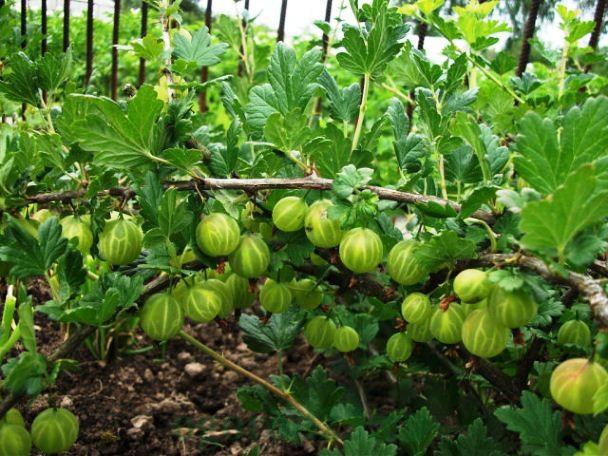
The division of the bush is carried out in spring and autumn. The main condition: the seedlings must have time to take root. In warm regions, the period from late September to early October is suitable. To divide the bush, it is important to wait for the gooseberry to hibernate, then it will transfer the separation painlessly. In regions of the temperate climatic zone, the bush is divided in the spring.
During the summer, the plant has time to prepare for the winter cold. But in this case, you need to be in time before the buds swell, since a plant that has not woken up will better tolerate this procedure.
When is it better to cuttings: summer or autumn?
Growth rates in gooseberries mainly depend on weather conditions, respectively, the appropriate propagation period for cuttings is different. Basically, cuttings are cut in early spring before the buds swell. It is necessary to plant in warm soil. During the summer, standard care measures are taken: watering, nutrition, loosening.
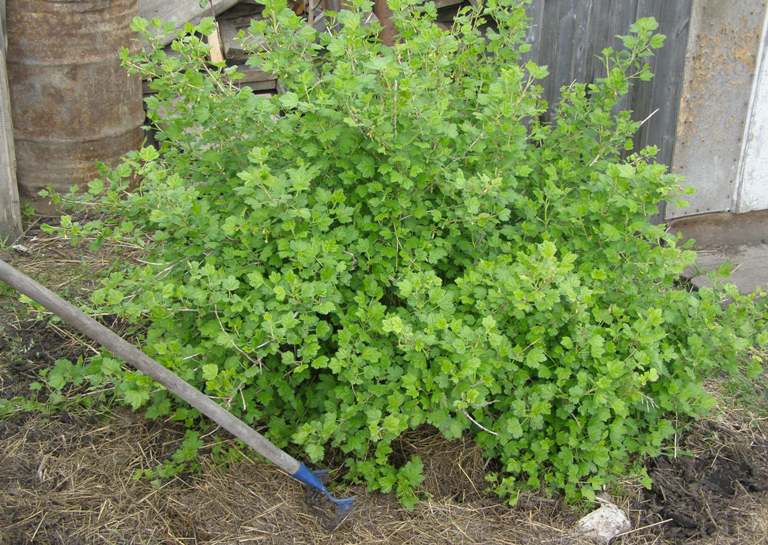
Autumn is suitable for propagation of a bush with lignified cuttings. In the winter period, the cuttings are stored in the cold; planting is carried out on May days in the warm ground.
Recommendations for novice gardeners
Breeding and growing the bushes of this plant is not difficult. For breeding, you need to choose a specific method, which depends on some factors:
- The age of the plant being used. It should have one- and two-year-old shoots.
- The gooseberry must be free from damage by insects, fungi and viruses.
- Preparation for the breeding process begins from the previous season. Careful care is taken for gooseberries: watering, feeding with fertilizers, preventive measures for diseases and attacks of harmful insects.
- The place of planting of the bush is determined in advance. Gooseberries need warmth and an abundance of light, the absence of which will affect the amount of harvest and the taste of the berries. An elevation will not suit the plant, the roots may freeze, and the lowland, since melt water accumulates there, the cold persists for a long time. A flat area protected from the north wind is considered ideal.
- The plant does not like high humidity.
- Pits for planting are prepared in 12-18 days, diameter - 0.4-0.6 m, depth - 0.6 m.
- You need to take into account the distance between the seedlings, it is determined by the dimensions of the bush. The optimum distance is 0.8 m between seedlings and 1.5 m between rows.
- If possible, it is recommended to plant so that the gooseberry bushes do not obscure each other (checkerboard pattern).
- In the process of planting, mix the extracted soil with fertilizers: humus, superphosphate, potassium sulfate (wood ash).
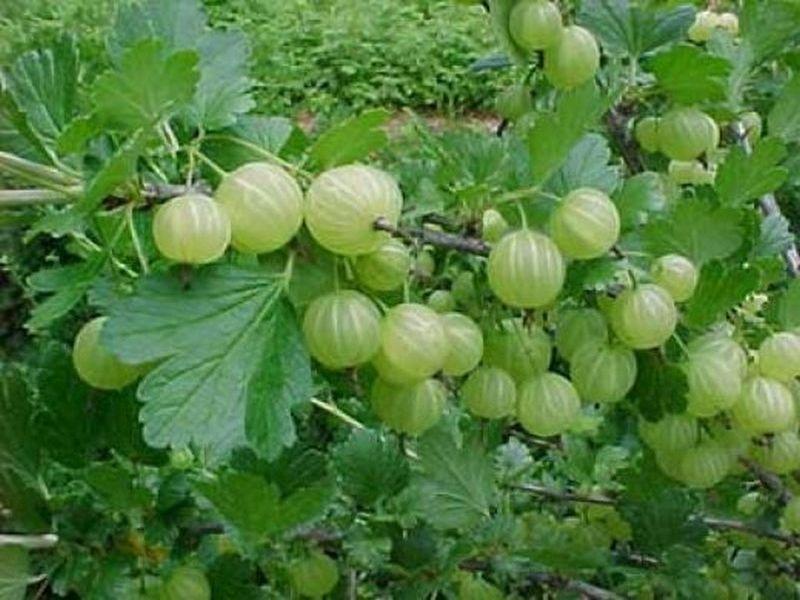
Gooseberry propagation methods and technology
There are many options for breeding gooseberries. The gardener is chosen for himself the most convenient and optimal.
Layers
There are three ways to breed gooseberries by layering, in which it is necessary to drop in branches or partially gooseberries.
Horizontal
This bush breeding option is recognized as one of the most effective. Implemented in October.In spring, it is also allowed to lay layering, but it should be done as early as possible, before the buds swell and as long as there is enough moisture in the soil. Optimal time: the last days of March - until mid-April. The term varies depending on the climatic regions.
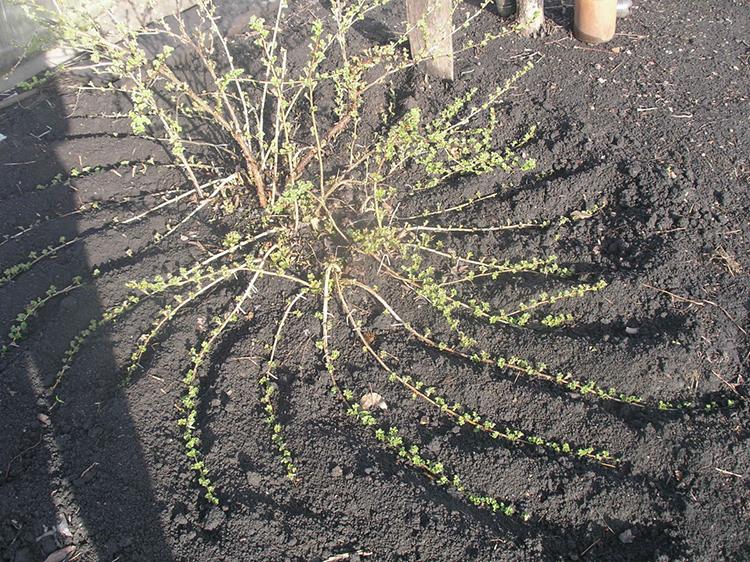
This requires:
- Choose healthy gooseberries. The preferred plant age is 5-7 years.
- Identify some good branches, age range from 1 to 3 years. They should be as close to the ground as possible.
- Cut off the growths on the branches by one third of their length. The procedure activates bud germination and the appearance of sprouts, the root develops well.
- Bend the branches to the soil, lay them in the previously prepared furrows, fasten them tightly with hooks made of metal, plastic, wood.
- Fill furrows with a fertile layer of earth, water, mulch.
- It is important to weed, fertilize and water in a timely manner.
- Buds on the deepened branches will begin to grow and form vertical shoots.
- When young shoots become 8-10 cm long, hilling must be done.
- September (last days) is the recommended time for a transfer. Separate a branch with rooted shoots with scissors or pruning shears from the mother bush, dig up, cut, taking into account the number of shoots obtained.
- Sort seedlings, shorten roots, cut off shoots by ¼ of their length.
- Plant on a prepared ridge.
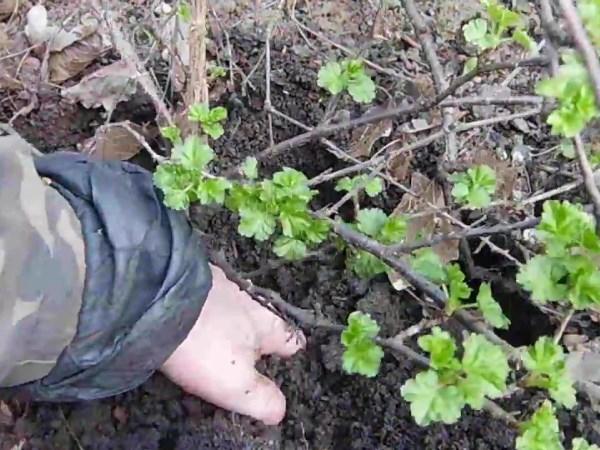
The main disadvantage of this breeding option is its labor intensity. Reliability of reproduction is considered an advantage.
Vertical
Breeding the bush with vertical layers is considered effective. Used for plant rejuvenation.
For this:
- In springtime, cover the bush with prepared, well-fertilized, moist soil. The height of the embankment is 10-15 cm. As the branches grow, periodically hilling.
- In the fall, if the work was carried out correctly, rooting will occur, and the separation of young seedlings can be carried out.
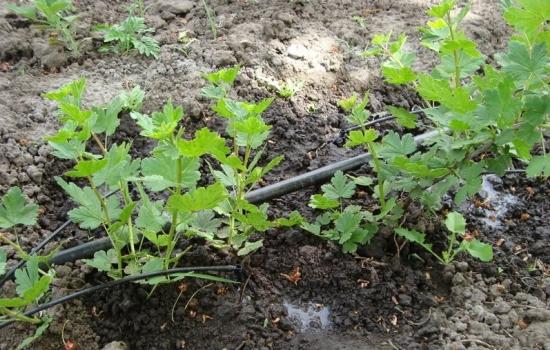
Arcuate layering
There are varieties of gooseberries that have arcuate soft shoots. They touch the ground and form roots quite actively. In such cases, rooting is carried out without human assistance. If you help the gooseberry bush, the process will go much faster.
This requires:
- In the place of contact with the surface of the soil, make a hole, place a twig in it, fix it and sprinkle with fertile soil mixture, forming a mound.
- In the fall, separate the sprout from the mother bush and dig it up.
- Examine the sprouts, taking into account their condition, they are sent for growing or planted on a permanent ridge.
Efficiency is recognized as the advantage of this method. The disadvantages include the fact that a single seedling is obtained from a branch. If reproduction is carried out for oneself, this is sufficient. This option is not suitable for industrial reproduction.
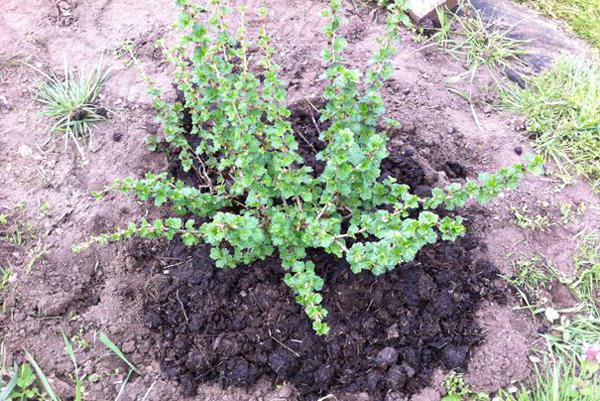
Perennial branches
It is recommended not to destroy the gooseberry twigs remaining after seasonal pruning, but to use them for breeding.
Recommended:
- make a depression in the soil;
- put a branch in it;
- sprinkle with fertile soil mixture, leave a part of the branch with a green growth of this season outside;
- to stimulate the lateral buds, it is recommended to pinch the green sprout;
- keep the soil moist;
- feeding is done after active growth;
- dig up in the autumn, divide into shoots;
- plant for growing on a special ridge.

By dividing the bush
The division is used if it is necessary to transfer a valuable bush to another ridge. To do this, you need to prepare the plant in advance:
- Cut off old branches under the base. Such a procedure will stimulate the growth of new ones.
- For the next season, dig up the gooseberries, divide them into parts.
- Plant the seedlings in the prepared pits. It is recommended to make this bush transplant in autumn and spring, but not in summer.
By cuttings
Gooseberry propagation by cuttings is carried out in the spring and autumn. The timing of gooseberry cuttings is in direct proportion to the type of cuttings harvested.
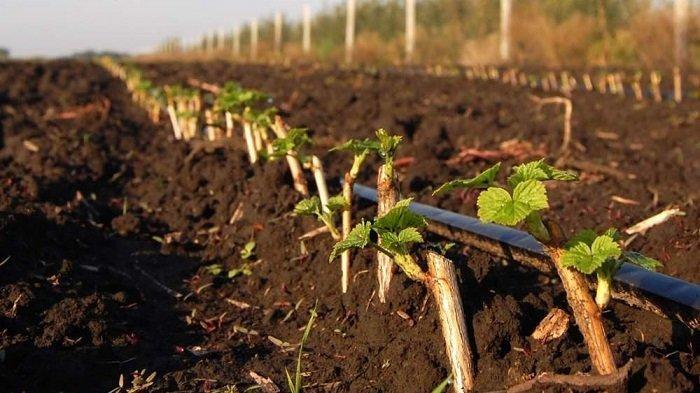
Green cuttings
This option is considered effective in comparison with lignified cuttings, so gardeners are often interested in how to propagate gooseberries with green cuttings in summer. The ideal time for this cuttings is from mid-June.
For cutting, it is recommended to take young growths of the current season. They must be harvested early in the morning, in the late afternoon.
Mostly the length of the blanks is 8-12 cm. You need to cut it with a knife or razor. Further, the resulting cuttings must be kept in a growth stimulator, which will contribute to their active rooting. Withstand about 12-14 hours at a temperature of 20-23 aboutFROM.
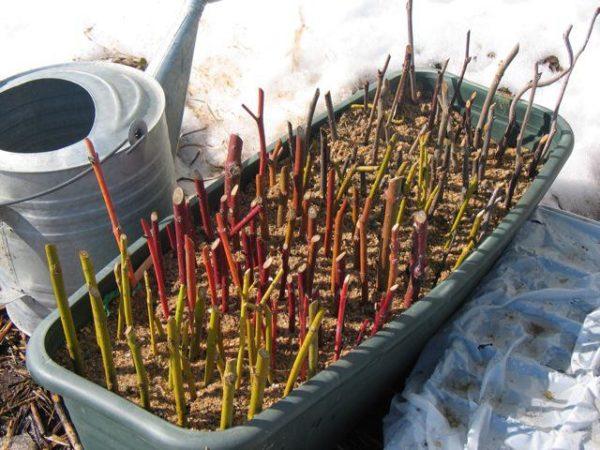
Prepare a special container. The soil in it is prepared from several layers: 1st (lower) - drainage (the plant does not tolerate excessive moisture), middle - fertile soil, upper - should consist of peat with humus and sand. The thickness of each layer is 0.1 m. To plant cuttings in it, deepening by 20 mm, water carefully.
For good rooting, special conditions are needed: warm and high humidity. Daytime temperature mode is recommended at least 18 aboutC, night no less than 16 aboutC. Watering is done with warm liquid.
During the hot period, the nursery opens slightly to prevent overheating.It is also necessary to shade from the rays of the sun. During the summer, feed the seedlings with urea or manure solution. After rooting, reduce the moisture content to 75%, gradually bring it to open ground conditions.

Lignified cuttings
Since the cuttings of this plant root poorly, gardeners are advised not to use cuttings. In industrial production, there is a great risk of not getting seedlings. But at home, if 3-4 out of a dozen cuttings take root, it will already be enough.
This requires:
- In early spring, prepare cuttings 0.2 m long. It is carried out until the plant wakes up, the buds are not swollen. In autumn, prepare cuttings just before planting. It is better to cut from the top of the shoots, they will root better in comparison with the lower ones.
- In the spring, plant only after thawing the soil to a sufficient depth. Before disembarkation, the workpieces are kept in the cold, wrapped in a dampened cloth or in a polyethylene bag.
- Land on the ridge. The distance between the cuttings is 0.2 m. To plant, observing an angle of 45about... In this case, the best conditions for rooting are obtained.
- After planting, thoroughly compact the soil between the cuttings, water carefully, preventing soil erosion, and mulch. The optimal mulch thickness is 6-7 cm.
- The soil must be carefully fluffed up, weeded out, and timely watering and nutrition should be done.
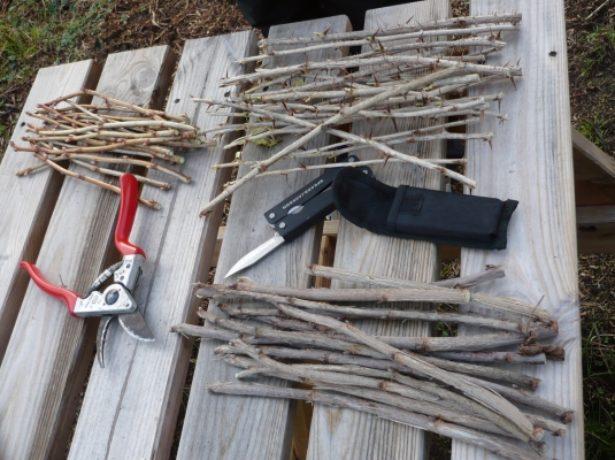
Combined cuttings
A stalk with a green sprout is considered to be combined, part of which contains last year's lignified growth with a length not exceeding 3-6 cm. Cuttings are harvested:
- with a heel: the branch breaks directly;
- with a crutch: cut off the green twig with a lignified fragment, the cut is carried out according to the dark growth of the previous season;
- with a stand: it is cut from a side branch, and the lignified fragment (crutch) is connected to the green one perpendicularly.
Gooseberry breeding begins at the end of May, when green shoots reach 50-70 mm in height, and then practically the entire growing season. Plant the cuttings in loose soil, deepening the heel and part of the base by 30-40 mm. Water the soil abundantly, make mulch. Roots appear in 12-16 days.
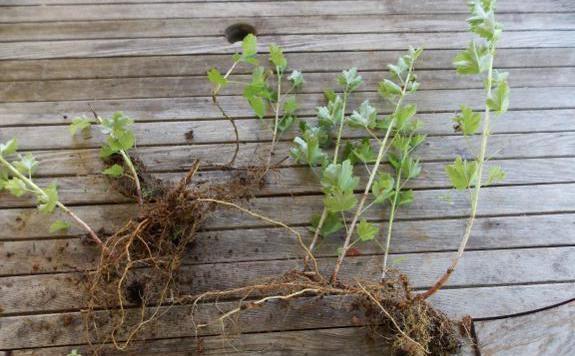
Seed breeding method for gooseberries
The seed is taken from ripe berries. They need to be mixed with sand and stored until autumn. For the winter period, bury the box at 0.5-0.7 m and cover with a layer of soil. In early spring, sow seeds in a greenhouse, cover with a layer of peat. You need to plant when 2 sheets appear. Seedlings are watered, weeded, nourished. In autumn, plant the matured shoots in the garden.
Growth reproduction
It is considered the most humane way. This is the timely deposition of the growth naturally formed by the bush. In spring, pinch the shoots for better branching. Reproduction is carried out in the fall, after the end of the season. The shoots are carefully separated from the bush and transferred to a new place. It is worth noting that if large berries are needed, the shoots must be harvested regularly.
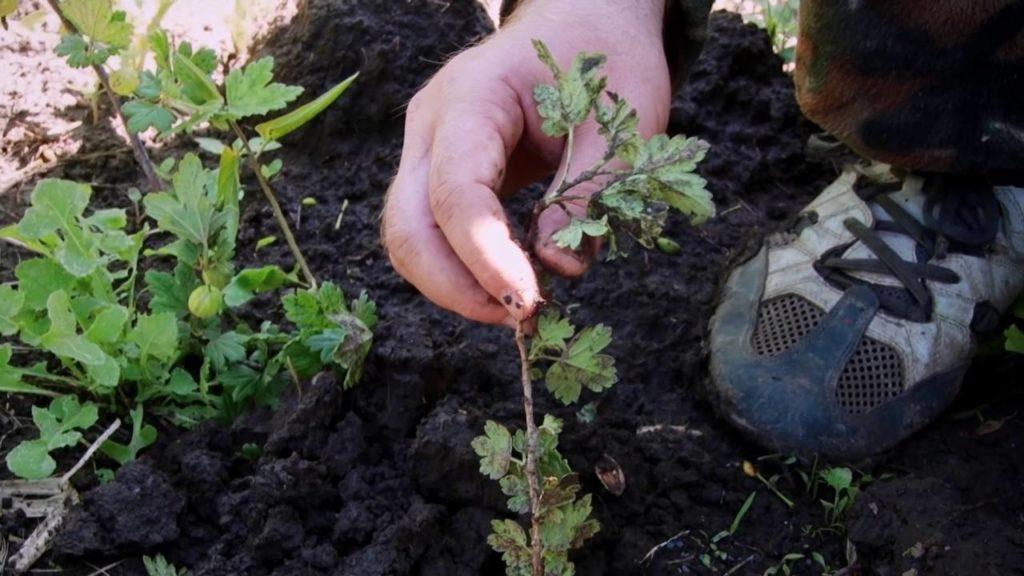
The nuances of breeding gooseberries without thorns
Thornless gooseberries will develop well given some of the nuances:
- does not tolerate soil of high acidity;
- does not like excessive moisture;
- tolerates several days of drought well;
- layering is the best breeding method.
Features of caring for young seedlings
Weeding, loosening, watering is carried out within the radius of the crown of the bush, since the root system does not go beyond the edges of the shoots. Loosening is carried out to a depth of 40 mm so as not to injure the roots, most of them are located at a depth of 50 mm. In stable weather, one-time watering is required per week.
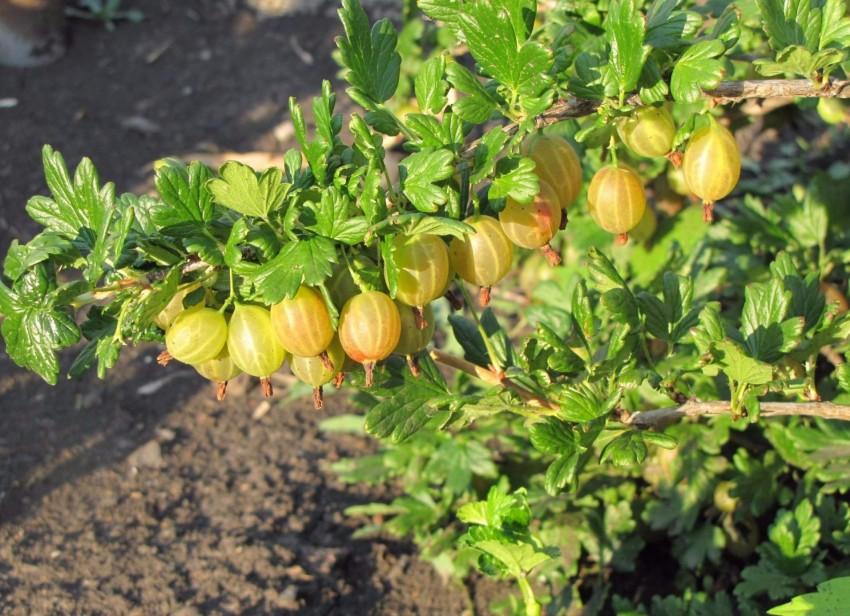
A sprawling bush will require a garter or support in the future. It is necessary to remove the basal shoots. Pruning in the fall. Sick and damaged branches are removed to the very soil.In the second year, you need to cultivate the soil, especially if manure was not used during planting. In the spring, saltpeter must be added.
After harvesting, it is recommended to remove the fallen leaves (pests can hibernate there), to carry out preventive treatment with fungicides ("Topaz") to prevent the development of diseases. To prepare for winter, the bush needs to be fertilized. Recommended: "Sotka Autumn", "Autumn", Bona Forte. Growing gooseberries is easy. With the correct implementation of all agrotechnical requirements, the bushes will delight with a tasty large harvest.
